Amazon Prime Video Buffering
In today’s digital age, streaming services have become a staple in entertainment consumption, offering an extensive library of movies, TV shows, and exclusive content at the click of a button. Among these services, Amazon Prime Video stands out as a popular choice, known for its diverse range of programming and seamless user experience. However, like any technology-dependent service, it’s not immune to technical hitches, and one common issue users often encounter is Amazon Prime Video buffering.
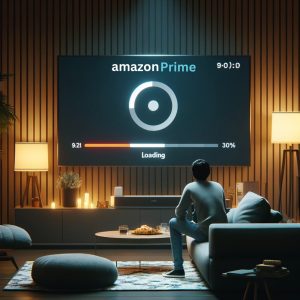
A smooth streaming experience is crucial in maintaining viewer satisfaction and engagement. No one enjoys their favorite show or movie being interrupted by constant pauses and load times. Amazon Prime Video keeps buffering can be a frustrating ordeal, significantly detracting from the overall viewing experience. Whether settling in for a movie night or catching up on a TV series, continuous buffering on Amazon prime can disrupt the flow and impact the enjoyment.
This problem isn’t unique to Amazon Prime Video; it’s a challenge faced by all streaming platforms. However, the frequency and severity of Prime Video buffering can vary based on a myriad of factors ranging from individual internet connectivity to server stability. Recognizing these issues is the primary step towards resolving them and ensuring a smooth, uninterrupted streaming experience.
In the following sections, we will explore the various causes of buffering on Amazon Prime Video, along with effective strategies and troubleshooting tips to help minimize or eliminate these disruptions. By addressing Amazon Prime Video buffering proactively, viewers can enhance their streaming sessions, making buffering delays a thing of the past.
What Causes Buffering on Amazon Prime?
Amazon Prime Video buffering issues can significantly detract from your viewing pleasure, turning an enjoyable movie night into a frustrating pause-and-play battle. Several factors contribute to these interruptions, and understanding them is crucial for resolving the underlying problems.
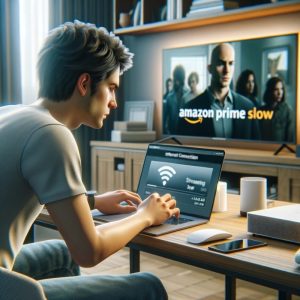
-
Internet Connection Problems:
One of the primary culprits behind Amazon Prime video buffering problems is internet connection issues. Slow internet speeds can struggle to keep up with the high data demands of HD streaming, leading to buffering. Unstable Wi-Fi signals further compound the problem, especially if your streaming device is far from the router or blocked by walls and other physical barriers. To diagnose whether your internet speed is the issue, conducting a speed test can be a helpful first step. Tools like Speedtest by Ookla or your internet service provider’s own test can determine if your speeds are adequate for streaming on Amazon Prime Video.
-
Device Performance Problems:
Another factor to consider is the performance of the device you’re using to stream. Overloaded device memory can slow down your device’s ability to process the streamed content smoothly, causing Amazon Prime Video to keep buffering. Similarly, outdated hardware or software can lack the efficiency required to handle modern streaming applications effectively. Ensuring that your devices are up-to-date and clearing any unnecessary data or apps from memory can help alleviate these issues.
-
Amazon Prime Video Server Issues:
On occasions, the problem may not even originate from your end. Amazon Prime Video itself can experience server issues, especially during high traffic times like the release of a new series or movie when many users log in simultaneously. Server downtimes, although rare, can also lead to buffering on Amazon prime. Monitoring social media platforms or official announcements can provide updates if this is the case.
-
Local Network Congestion:
Lastly, local network congestion can play a significant role in how well Amazon Prime Video The more devices connected to your network, all possibly downloading, uploading, or streaming content, the more your bandwidth is divided. High-bandwidth activities like large file downloads or other streaming services can also impact your available bandwidth, leading to buffering Amazon Prime. Managing the number of connected devices and the types of activities performed during streaming sessions can significantly improve your streaming quality.
By addressing these varied causes—ranging from buffering on Amazon prime due to slow internet, to device issues, server-side problems, and local network congestion—you can better diagnose and fix the buffering dilemmas for a smoother Amazon Prime Video experience.
How to Fix the issue of Buffering on Amazon Prime Video
Experiencing buffering on Amazon Prime can be quite aggravating, especially when you’re looking forward to relaxing and watching your favorite shows or movies. Fortunately, there are a number of strategies you can implement to minimize or even prevent Amazon Prime video buffering.
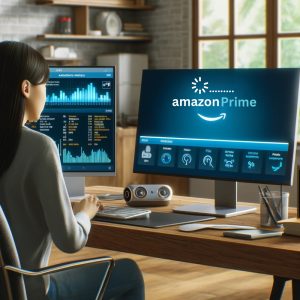
-
Improving Internet Speed and Stability for Amazon Video
A strong and steady internet connection is important to prevent buffering on Amazon prime. Here are a few ways to optimize your Wi-Fi network:
-
-
Position your router in an optimal location:
Centralize the router in your home, away from walls and obstructions to improve signal strength.
-
Limit interference:
Keep your router away from other electronics like microwaves and cordless phones, that could interfere with the signal.
-
Update your router’s firmware:
Regular updates can improve performance and stability.
-
Choosing the right internet plan:
If your current internet speed struggles to meet the demands of streaming, it may be time to upgrade to a faster plan. Most streaming services recommend at least 5 Mbps for HD quality and 25 Mbps for ultra HD content.
-
-
Enhancing Device Performance to Prevent Amazon Prime Video Buffering
To ensure your device runs Amazon Prime Video smoothly, consider the following:
-
-
Clearing cache and data on devices:
This can free up your device’s memory and eliminate stored data that might be slowing down your device.
-
Updating device firmware and Amazon prime apps:
Regular updates add new features and fix bugs that might be causing Amazon video buffering.
-
Rebooting devices:
Sometimes, a simple reboot can refresh your device’s operating system and fix minor glitches contributing to Amazon prime video buffering.
-
-
Adjusting Amazon Prime Video Streaming Settings
Adapting the streaming quality settings to better match your internet speed can significantly reduce Amazon Prime video keeps buffering:
-
-
Changing video quality to match bandwidth:
Auto settings in streaming apps adjust video quality in real-time based on your internet speed. However, manually setting a lower resolution can help avoid buffering if your internet speed is inconsistent.
-
Reducing the stream quality manually of Amazon Prime:
If you notice frequent buffering, consider lowering the video quality settings manually to reduce the amount of data being used. If the issue of streaming still sustains, you can read out in-depth blog on Amazon Prime streaming issues and get the solution for it.
-
-
Network Equipment Adjustments
Upgrading or adjusting your network equipment can offer long-term solutions to buffering on Amazon Prime:
-
-
Upgrading routers or modems:
Investing in a more advanced router or modem can provide a stronger and more reliable connection.
-
Using Ethernet connections over Wi-Fi when possible:
An Ethernet cable directly connected from your modem to your streaming device can provide a more stable and faster connection than Wi-Fi, significantly reducing buffering on Amazon Prime.
-
By implementing these strategies, you should see a noticeable improvement in your streaming experience, keeping the Amazon Prime video buffering to a minimum. Enjoy your viewing without the frustrating interruptions of buffering, and make the most of your Amazon Prime Video subscription.
Advanced Troubleshooting to Prevent Buffering on Amazon Prime
When the usual solutions don’t resolve the persistent buffering on Amazon Prime, exploring more sophisticated troubleshooting methods is necessary. These advanced techniques are designed to tackle deeper issues that could be causing Amazon Prime Video keeps buffering.
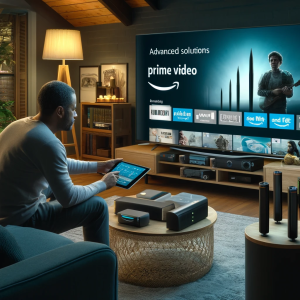
-
Changing DNS Settings
The Domain Name System (DNS) functions like the internet’s directory, translating domain names into IP addresses so that browsers can load online resources. Occasionally, the DNS provided by your Internet Service Provider may not be the fastest or most reliable, which can affect your streaming experience with Amazon Prime Video.
-
-
Benefits of switching DNS:
Opting for a public DNS server such as Google DNS or OpenDNS can lead to quicker domain name resolutions, which may help to alleviate Amazon Prime Video keeps buffering. Many users find that switching their DNS settings enhances overall streaming performance and decreases the frequency of buffering on Amazon Prime.
-
How to change DNS settings on common devices:
You can adjust DNS settings across various devices. On computers, navigate to the control panel, select Network and Internet settings, and alter your connection’s properties to include a preferred DNS server. For mobile devices, DNS settings typically reside under each Wi-Fi network’s specific settings within the Wi-Fi options.
-
-
Checking for External Interferences
External interferences can significantly contribute to buffering on Amazon Prime. It’s crucial to consider both physical obstructions and electronic interferences that might compromise your Wi-Fi connectivity.
-
-
Physical barriers affecting Wi-Fi:
Your Wi-Fi signal can be obstructed by walls, floors, and other substantial objects. Materials like metal or concrete, often used in building construction, are particularly disruptive to Wi-Fi signals. To enhance your streaming quality on Amazon Prime Video, place your router in a more central and open location to minimize these obstacles.
-
Other devices causing interference:
Various household electronic devices, such as baby monitors, cordless phones and microwaves can hinder Wi-Fi signals. Bluetooth devices are also known to cause disruptions. To reduce Amazon Prime keeps buffering, keep such devices away from your router and streaming devices.
-
Utilizing these advanced troubleshooting steps can help solve the more complex causes behind Amazon Prime video buffering. By enhancing your network’s performance and stability, you can enjoy a seamless and more consistent streaming experience on Amazon Prime Video.
Preventing Future Buffering Issues on Amazon Prime Video
Consistent and proactive measures are essential to prevent future buffering issues on Amazon Prime. Establishing a routine for regular maintenance and employing the right tools can significantly reduce the occurrence of Amazon Prime video buffering issues, ensuring a seamless streaming experience on Amazon Prime Video.
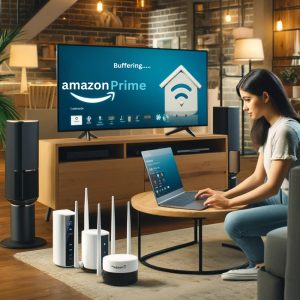
-
Regular Maintenance Tips for Devices and Network
Maintaining your devices and network is the key to minimize Amazon Prime video keeps buffering. Here are several maintenance practices you can adopt:
-
-
Regularly reboot your devices:
A simple reboot can refresh the system and clear temporary caches that may slow down your device and cause buffering on Amazon Prime.
-
Keep software up to date:
Ensure that all your streaming devices and your router’s firmware are regularly updated. Updates often include performance improvements that can prevent Amazon Prime video buffering issues.
-
Clean up device storage:
Over time, devices can get cluttered with unused apps and large files, which can impact performance. Regularly cleaning out these files can help maintain optimal device performance and reduce buffering on Amazon Prime.
-
-
Recommended Tools for Monitoring Network Performance
Using tools to monitor your network can help you to identify and resolve issues before they affect your streaming quality. Here are a few tools that can help:
-
-
Wi-Fi analyzers:
Apps like Wi-Fi Analyzer for Android or NetSpot for Windows and Mac can help you assess your Wi-Fi signal strength throughout your home. This can help you optimize router placement to ensure strong signal coverage, reducing Amazon Prime video keeps buffering.
-
Speed tests:
Regular use of speed test tools like Speedtest by Ookla can help you monitor your internet speed. Consistent speeds below what is needed for HD streaming on Amazon Prime Video might indicate a need for a better internet plan or troubleshooting with your ISP.
-
-
Importance of Regular Updates and Checks
Keeping everything up to date and performing regular checks is crucial for preventing buffering on Amazon Prime:
-
-
Schedule regular updates:
Most devices allow for automatic updates, but manually checking for updates can ensure you are always running the latest software, which can prevent Amazon Prime video keeps buffering.
-
Regularly check your network’s health:
Tools that monitor internet uptime and downtime, like Fing or PingPlotter, can provide insights into the stability of your connection. Identifying and addressing intermittent connectivity issues can help mitigate Amazon Prime video buffering issues.
-
By applying these preventative measures, you can greatly reduce the likelihood of experiencing buffering on Amazon Prime. Regular maintenance, utilizing the right tools, and keeping everything up to date are key steps in ensuring that your streaming experience on Amazon Prime Video remains uninterrupted and enjoyable.
FAQs
Q1. Why does Amazon Prime Video Keeps Buffering?
- A. Amazon Prime Video buffering can occur due to several reasons, including slow internet speeds, outdated device software, network congestion, or server issues from Amazon’s side. Regularly updating your devices and maintaining a stable internet connection can help reduce buffering.
Q2. What can I do if my Amazon Prime Video Keeps Buffering due to slow internet speeds?
- A. If Amazon Prime video keeps buffering because of slow internet, try improving your connection by upgrading your internet plan, positioning your router optimally without obstructions, or connecting your device via Ethernet instead of Wi-Fi.
Q3. How can I fix buffering on Amazon Prime caused by my device performance?
- A. To fix buffering on Amazon Prime due to device issues, clear the cache on your streaming device, ensure your device’s software is up-to-date, and restart your device to free up memory and processing power.
Q4. Why does Amazon Prime Video Buffering occur during peak hours?
- A. Amazon Prime Video buffering during peak hours often happens due to high traffic on Amazon’s servers or heavy internet usage in your local area, leading to network congestion. Watching during off-peak hours or reducing the video quality can help alleviate this issue.
Q5. What advanced settings can I adjust to prevent Amazon Prime Video from buffering?
- A. Adjusting advanced settings such as your DNS server can help prevent Amazon Prime Video from buffering. Switching to a public DNS like Google DNS or OpenDNS might improve your streaming experience.
Q6. How does changing DNS settings help if Amazon Prime Video Keeps Buffering?
- A. Changing DNS settings can help if Amazon Prime Video keeps buffering by potentially speeding up the loading time of streaming content, as some DNS servers can resolve domain names faster than others provided by your ISP.
Q7. Can other devices affect my Amazon Prime Video Keeps Buffering?
- A. Yes, other devices connected to your network can contribute to Amazon Prime Video keeps buffering. Devices like microwaves, baby monitors, and Bluetooth devices can interfere with Wi-Fi signals, affecting streaming quality.
Q8. What should I do if Prime Video Buffering issues persist even after following these tips?
- A. If prime video buffering issues persist, it might be useful to contact your ISP to check if there are issues with your internet service or Amazon support to report and troubleshoot potential server-related problems.
Q9. How can I monitor my network to understand why does my Prime Video Keep Buffering?
- A. To understand why your Prime Video keep buffering, use network monitoring tools like Wi-Fi analyzers or speed tests regularly to check the stability and speed of your internet connection.
Q10. What regular maintenance should I perform to prevent Prime Video from Buffering?
- A. To prevent prime video from buffering, regularly reboot your router and streaming devices, update your devices’ firmware and software, and clear the cache to ensure optimal performance.
Conclusion
Throughout this blog, we’ve explored a range of solutions and strategies aimed at resolving the common and disruptive issue of buffering on Amazon Prime. From understanding the various causes, such as internet connection issues and device performance problems, to implementing specific fixes like optimizing your Wi-Fi setup and updating your hardware and software, we’ve covered the essential steps to tackle Amazon Prime video keeps buffering.
We’ve also delved into advanced troubleshooting techniques for those who experience persistent problems, suggesting changes in DNS settings and addressing external interferences. Furthermore, we emphasized the importance of preventative measures, such as regular maintenance and using network monitoring tools, to sustain a stable streaming environment and prevent future Amazon Prime buffering issues.
By following these detailed tips and consistently applying the recommended practices, you can greatly enhance your viewing experience on Amazon Prime Video. No one should have to endure the frustration of a movie or show being interrupted by endless buffering. Taking proactive steps to enhance and maintain your network and device performance can lead to significantly fewer interruptions.
Whether you’re a casual viewer or an active binge-watcher, implementing these solutions will help ensure that your next streaming session is smooth and enjoyable. Remember, a little effort in troubleshooting and maintenance can go a long way in eliminating Amazon Prime keeps buffering issues. So, embrace these strategies, enjoy your favorite content without interruptions, and transform your Amazon Prime Video experience into one that is truly seamless and pleasurable.
To know more about Amazon Prime Video Keeps Buffering and other related issues and their solutions, visit our Amazon Prime Video Support page.

Elizabeth nelson
What are the primary reasons my Amazon Prime Video keeps buffering during movie nights, and how can I effectively diagnose and resolve these issues?
Support Admin
If your Amazon Prime Video keeps buffering, it’s essential to start with your internet connection problems. A simple speed test can help verify if your internet speeds are adequate for streaming HD content. If the internet isn’t the issue, consider potential device performance problems—ensure your streaming device isn’t overwhelmed with open apps or outdated software. Next, look into local network congestion; other devices might be consuming the bandwidth necessary for smooth streaming. Lastly, it’s worth checking for any Amazon Prime Video server issues online or through social media updates from Amazon’s official channels.